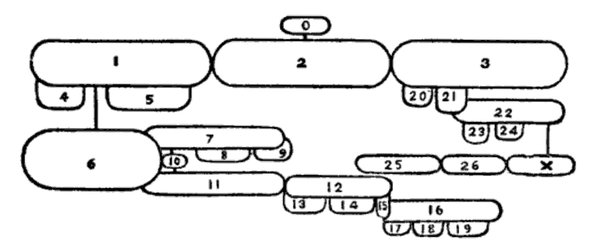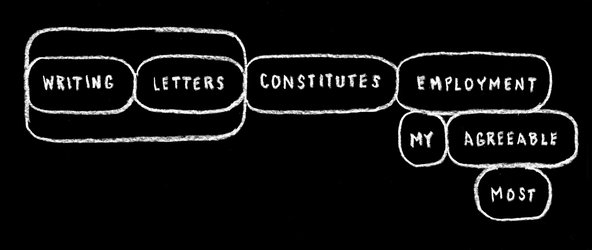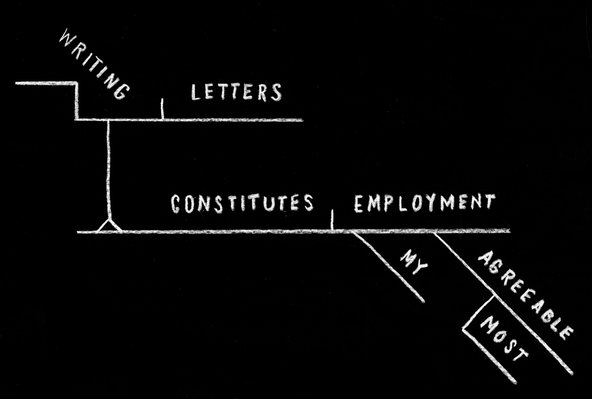A Picture of Language
The curious art of diagramming sentences was invented 165 years ago by S.W. Clark, a schoolmaster in Homer, N.Y. [1] His book, published in 1847, was called “A Practical Grammar: In which Words, Phrases, and Sentences Are Classified According to Their Offices and Their Various Relations to One Another.” His goal was to simplify the teaching of English grammar. It was more than 300 pages long, contained information on such things as unipersonal verbs and “rhetorico-grammatical figures,” and provided a long section on Prosody, which he defined as “that part of the Science of Language which treats of utterance.”
It may have been unwieldy, but this formidable tome was also quite revolutionary: out of the general murk of its tiny print, incessant repetitions, maze of definitions and uplifting examples emerged the profoundly innovative, dazzlingly ingenious and rather whimsical idea of analyzing sentences by turning them into pictures. “A Practical Grammar” was a reaction against the way the subject had been taught in America since it began to be taught at all.
Before diagramming, grammar was taught by means of its drabber older sibling, parsing. Parsing is a venerable method for teaching inflected languages like Latin; the word itself is schoolboy slang derived from pars orationis, Latin for “a part of speech.” Sometime in the 18th century, teachers began to realize that practical skills were more useful to young people than classical languages, and that the ability to speak English didn’t necessarily mean that a student spoke it well, wrote it correctly or understood its structure. To teach it, they borrowed the concept of parsing from the classical tradition in which they themselves had been trained.
Put simply, parsing requires the student to break down a sentence into its component words, classifying each in terms of its part of speech, as well as its tense, number and function in the sentence.
Let’s say a teacher assigns a student the sentence “Virtue secures happiness”—a likely specimen in 1847. The youth stands up, spouts something like, “Virtue is a singular noun and the subject of the sentence; secures is a regular verb, indicative mode, active voice, present tense, third person singular; happiness is a singular noun, object of the sentence,” and sits back down with a sigh of relief.
Parsing was almost insufferably tedious. It was also very difficult. And both these deficiencies were intensified by the way grammar was taught. Typically, students were first made to memorize definitions and rules, and only when they could recite them accurately by rote were they expected to apply them to sentences.
Stephen Watkins Clark was the principal at the Cortland Academy, where he also taught English. Like many schoolmasters, he was frustrated trying to beat proper grammar into the heads of his students by means of parsing. Mr. Clark was not the first reformer to identify its problems, but he was the first to solve them by arranging the parts of a sentence into diagrams. He didn’t consider the idea particularly radical. As he notes in his preface, making the abstract rules of language into pictures was like using maps in a geography book or graphs in geometry.
But there are differences. Maps and geometric diagrams are ancient; both go back at least to the Greeks. Geometry, of course, can’t be taught without recourse to geometric figures, and schoolchildren can draw a map of their classroom or their front yard without much instruction from the teacher. But making a picture of the sentences we read and speak every day was a concept with no real history behind it: it was invented not by an ancient on the other side of the world but in Mr. Clark’s study, in his classrooms, on long meditative walks around the town of Homer.
And, radical or not, it apparently caught on at the academy. His fellow teachers urged him to take it public, and he wrote the book.
Mr. Clark’s early diagrams were basically balloons, though they might be mistaken for a fleet of airships or a family of hot-dog rolls:

Mr. Clark provided this diagram as a generic template for his students, with numbers assigned to different elements in the sentence.
Applied to the analysis of an actual simple sentence — 1 being the subject (noun), 2 the predicate (verb) and 3 the object — the balloons could be pleasantly straightforward:
or unpleasantly convoluted:

From “A Practical Grammar” - “Our national resources are developed by an earnest culture of the arts of peace.”
Mr. Clark’s balloons weren’t that easy to draw. Do you make the circle and then write the word inside it, or write the word and then draw a balloon around it? Either way, try doing it on a slate with a piece of chalk, and the noble sentiments Clark prefers for his models look like cartoonish nonsense:
“A Practical Grammar” went into several editions (my own copy, from 1860, is the 15th), but in the history of diagramming, the reign of the balloons was relatively brief. In 1877 two teachers — Alonzo Reed and Brainerd Kellogg — left them deflated on the classroom floor. Their book “Higher Lessons in English” finessed Mr. Clark’s bulky blobs into a system of lines and angles that were a snap to draw and took up less space.
The book was enormously popular, and Mr. Reed and Mr. Brainerd’s diagramming swept through American schools like a refreshing breeze. By the latter half of the 19th century, chalkboards had become increasingly common in classrooms; for students, the impact of watching a sentence take shape on that large surface as a comprehensible, often elegant, and sometimes downright ingenious drawing must have been significant. It’s hard to believe anyone but the most dedicated pedant could have actually enjoyed parsing, but plenty of students — including me — loved diagramming.
A century and a half later, diagramming sentences is even more out of date than writing lessons on a piece of slate. When the book I wrote about it was published in 2006, a couple of hundred people sent me e-mails. One writer accused me of succumbing to Stockholm syndrome because I wrote so benignly about the nun who brainwashed me into thinking diagramming was fun. Another asked me for a date. Two objected to my political attitudes, as they deduced them between the lines. A dozen or so either faulted some of the diagrams or challenged me with a particularly tricky sentence.
The rest of the responses were eloquent, nostalgic and not unpersuasive laments for the lost art of diagramming, from people who blame everything from the death of whom to the end of civilization as we know it for its demise.
The question remains: Does diagramming sentences teach us anything except how to diagram sentences?
That particular can of worms is a subject for another post.
[1] The word “ago” is problematic in the diagram. There are other possibilities, but I have treated “years ago” as a phrasal adverb modified by “165.”
 Kitty Burns Florey is the author of several works of nonfiction, including “Sister Bernadette’s Barking Dog: The Curious History and Lost Art of Diagramming Sentences” and fiction, most recently a historical novel, “The Writing Master.”
Kitty Burns Florey is the author of several works of nonfiction, including “Sister Bernadette’s Barking Dog: The Curious History and Lost Art of Diagramming Sentences” and fiction, most recently a historical novel, “The Writing Master.”




